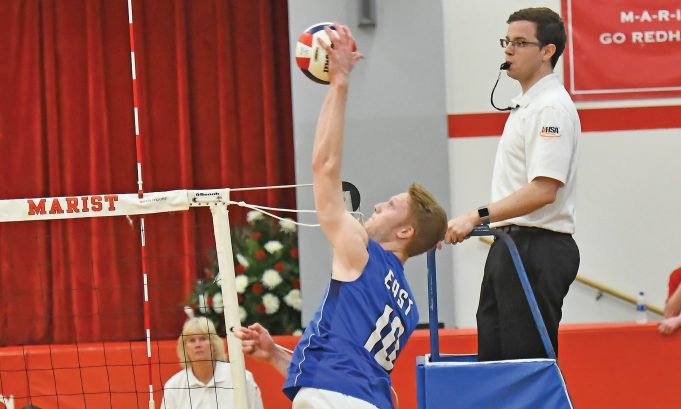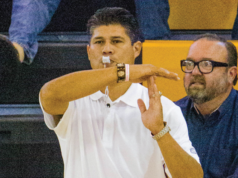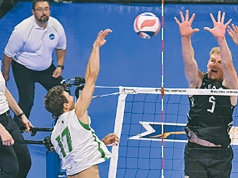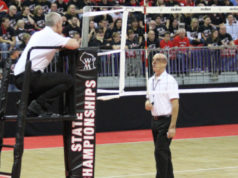Catch, lift, throw, hold, grab, monster dunk! OK, we have all heard the terms thrown out there for one of the now common plays in volleyball. Players use a strategy of not “hitting” the ball on an attack but directing the ball in a specific direction with their hand. This play poses a challenge for us as referees.
Because this contact is subtle, it becomes a judgment call. I believe, next to calling a double contact consistently, this is becoming one of the hardest judgments to make, due to the increased athleticism of today’s players.
There can be so many factors that come into play to determine whether or not these contacts are legal. And because some are seeing this tactic for the first time, it puts a lot of pressure on referees to make the right call. It’s important to remember that aspect as volleyball playing styles vary around the country. I have heard experienced officials say, “They are allowing that now.” It is not that we are allowing something illegal to occur. It is an ever-evolving part of the game. So we must improve our skills with the game.
This strategic play evolved from the basic “tip,” where players use their fingertips to lightly send the ball over the top of the block. That technique was taken a step further when we started seeing the middle blockers directing an overpass one way or another to avoid the opponents’ contact. You may have seen the middle blocker use two hands to change the direction of the ball significantly on a block. This is a critical part of game strategy. We may also see attackers use a one-hand finger-action to push the ball deep into the opponent’s court. Some players have yet to master this skill and their contacts may result in a catch/throw action. If there is prolonged contact, it is a fault, and needs to be called as such.
To determine whether a contact is legal we are stuck with a line from the famous Whitney Houston song, “How will I know?”
What is prolonged contact?
NFHS rule 9-4.5: “Legal contact is a touch of the ball by any part of a player’s body which does not allow the ball to visibly come to rest or involve prolonged contact with a player’s body.”
NCAA Women’s rule 14.2.2: “The ball must be hit cleanly and not caught or thrown. Prolonged contact with the ball is a fault. The ball can rebound in any direction.”
USAV rule 9.3.3: “Catch: The ball is caught and/or thrown; it does not rebound from the hit.”
As with any ballhandling call, watching the hands is key. There are two elements that can be used to help determine the legality of the contact:
- Where is the hand/arm in relation to the body at the point of contact?
- Where on the hand is the ball making contact?
Let’s look at the hand/arm position. If the hand and arm are behind the player’s head when initial contact is made, although not absolute, there is a very good chance the ball will come to rest as the player attempts to impart forward motion on the ball. These can be easier to see.
As for how the hand is making contact, the ball should be on the fingertips. If the ball is landing in the palm along with the fingertips, it is more likely that the ball has come to rest, and therefore a ballhandling fault has occurred.
The boys’ and men’s game have a different level of physical athleticism, and this is where we tend to see this happening more. It seems that sometimes the guys get caught up in the basketball mentality of the “monster dunk” and try to throw the ball down. Because male hands are generally larger, it is easier for them to wrap their hand around the ball in a grabbing motion, causing the ball to truly be caught and thrown. The key takeaway is no matter where the contact occurs, the ball must rebound off the player to not have prolonged contact.
Because this is a judgment call, you may experience more questioning from players and coaches. Remember, they are possibly learning the boundaries of this infraction just as some officials are. If the coach or captain asks for an explanation, use the language from the rulebook. “Coach (or captain), there was prolonged contact on the ball.” You don’t need to talk about where the hand was or how it was shaped around the ball.
As always, take the opportunity to watch more seasoned officials at all levels. Observe what they are calling and don’t be afraid to ask them questions. I have never had an official not take the time to answer a question for me. We are all learning and striving to be better. Trust your judgment and be confident in your calls.
Paul Wilk, Aurora, Ill., served as a line judge for the 2019 Illinois High School Association Boys’ State Finals. He is a member of PAVO and has been a referee for 10 years.
What's Your Call? Leave a Comment:
Note: This article is archival in nature. Rules, interpretations, mechanics, philosophies and other information may or may not be correct for the current year.
This article is the copyright of ©Referee Enterprises, Inc., and may not be republished in whole or in part online, in print or in any capacity without expressed written permission from Referee. The article is made available for educational use by individuals.


















